
Ten Years After the Deluge: Revisiting the Central Europe Floods of 2005
Aug 26, 2015
Editor's Note: The 2005 flood was the most expensive natural disaster in Switzerland's history and also caused considerable economic losses in Austria, Germany, Romania, and Bulgaria. This article takes a look back at what happened and examines a present-day recurrence of the event using AIR's new Inland Flood Model for Central Europe.
Inland flooding is one of the most frequent natural hazards in Europe and causes up to one third of the average annual catastrophe losses. In August 2005, just three years after "the flood of the century" in 2002, Central Europe was struck again, this time sustaining economic damage totaling about EUR 3 billion. The 2005 floods primarily impacted Switzerland, Austria, and Germany, as well as countries on the Danube, such as Romania and Bulgaria. Due to the heavy damage in the Alpine region, the 2005 floods became known as "the 2005 Alpine floods." This and other damaging floods during the past decades have demonstrated that understanding and managing flood risk in Europe has never been more critical.
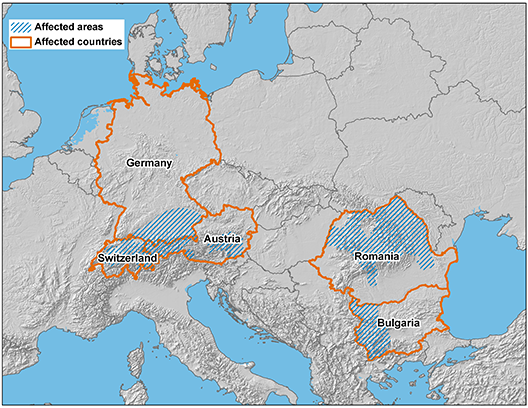
Meteorological Background
During the past few decades, most of Central Europe's major floods have been caused by a so-called Vb (pronounced "five-b") weather situation, and the 2005 flooding in Central Europe was no exception. During a Vb weather event, a low pressure system moves eastward from Iceland and encounters arctic air masses that divert the cyclone to the south toward the Mediterranean, where it picks up warm, moist air. The cyclone then curves toward the northeast and the air is lifted by the mountain ranges of Central Europe. Typically, the result is very intense and persistent rainfall over an extended area.
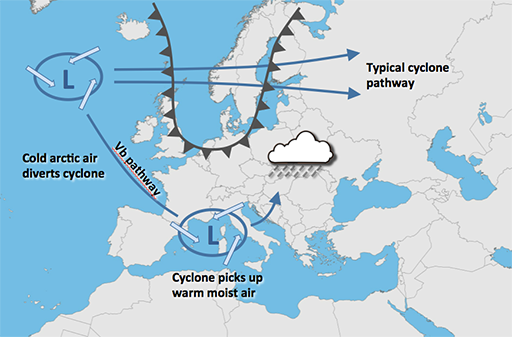
Flood Impact
The 2005 floods were the most expensive natural disaster in Switzerland's history and also caused considerable economic losses in Austria, Germany, Romania, and Bulgaria (see Table 1).
| Country | Core Period | Economic Losses (Millions of Euros) | Insured Losses (Millions of Euros) |
| Switzerland | August 14–23, 2005 | 1,870–1,950 | 804–1,580 |
| Austria | August 19–23, 2005 | 515–583 | 150 |
| Germany | August 20–23, 2005 | 185 | >30 |
| Romania | August 3–9, 2005 | 1,636.9 (includes spring events) | >12 |
| Bulgaria | August 4–7, 2005 | 436 (includes spring events) | >12 |
An overview of the impact in each country, as well as post-flood response, is provided in the sections below. After the flood, the affected countries undertook the task of improving flood protection through better communication to the public, information access for scientists, and more resilient physical infrastructure.
However, flood risk is still rising throughout Europe because of increasing concentrations of exposure along flood-prone rivers. Moreover, the tremendous increase in impervious surfaces due to urbanization continues, further increasing the risk—especially from brief, but extreme precipitation that lead to pluvial (or off-floodplain) floods.
Switzerland
Economic losses from the 2005 floods totaled about EUR 2 billion in Switzerland. The cantons of Bern, Luzern, Url, and Obwalden were most affected, representing about 70% of the countrywide losses. Throughout Switzerland heavy rainfall (more than 200 mm within 48 hours in some areas) led to saturated soils. Numerous valleys on the northern slopes of the Swiss Alps, as well as pre-Alpine areas in eastern Switzerland, were affected by flooded mountain streams and rivers.
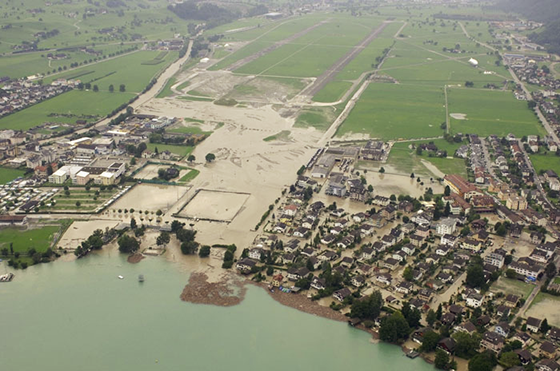
In several catchments rivers reached 1-in-100-year flows, and at some river gauges new historical records were set. The flooding damaged public infrastructure, as well as residential, commercial, and industrial buildings, and agricultural areas. Several valleys were cut off by ensuing landslides. The last event with a comparable damage pattern occurred in 1910.
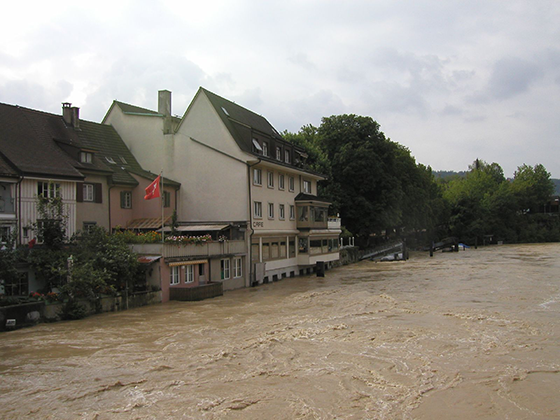
After the 2005 floods, flow regulations were systematically surveyed across all cantons to improve coordination and to provide the maximum possible flood protection for all larger settlements along rivers. Renaturation projects were initiated to give rivers more space and reduce flow velocity. Only two years later, during the 2007 floods, these measures proved successful in many parts of the country. Detailed hazard maps were created after 2005, and improved access to warnings, weather forecasts, and other real-time information was made available.
Austria
In Austria economic losses amounted to more than EUR 500 million. The worst affected states were Tyrol, Vorarlberg, Styria, and Salzburg. Styria received the entire average August rainfall amount between August 20 and August 22, and Tyrol and Vorarlberg received between 120 mm and 240 mm of rainfall in less than 24 hours on August 22, also equaling the monthly average for August. Extreme river flows (up to 1-in-100 years) in Tyrol and Vorarlberg, exacerbated by already saturated soils, resulted in large-scale flooding, exceeding previous events from 1999 (popularly known as "the Pentecost flood") and 2002. The situation was similar in Styria, where landslides followed the heavy rainfall in the southwest of the region. In the city of Graz, several urban streams burst their banks.
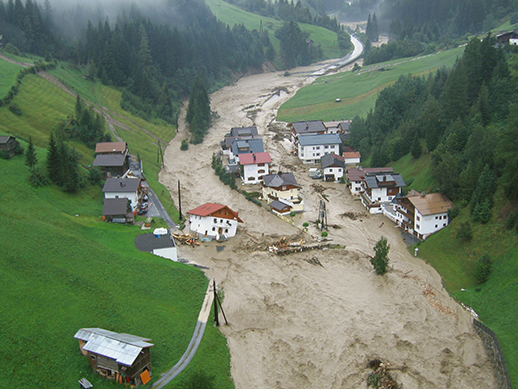
In the past decade, Austria has invested significant resources in improving its flood resilience. Real-time rainfall, river flow data, and flood maps for various recurrence intervals can now be retrieved online. In addition, early flood warning systems were developed for several rivers, and warning systems for major rivers such as the Danube and the Salzach were improved. Many of the measures that were implemented helped to avoid damage during recent floods in the summers of 2013 and 2014, which affected large areas that had also been impacted by the 2005 floods.
Germany
The reported economic losses in Germany, at about EUR 185 million, were low relative to Switzerland and Austria. Southern Bavaria was most affected. Rivers in the catchments of the Iller, Lech, Loisach, and Isar rivers reached flows of 1-in-100 years and up to more than 1-in-500 years in some locations. New flow records were established at a fifth of the river gauge stations, although total rainfall amounts in the region were lower than in 1999. These new extremes were related to exceptionally steep rising flood waves within a few hours, caused by extreme rainfall amounts within just 12 hours on already saturated soils. Some regions were completely cut off by the floods.
In the aftermath, the Bavarian and German governments refocused efforts on the "flood protection program 2020" that had been proposed after the floods in 1999 and approved in 2001. This program contains measures for new flood defenses, new flood retention basins, the relocation of levees, and the improvement of early warning systems. The 2005 events also revived discussions about obligatory insurance in Germany for natural hazards, similar to Switzerland where they are covered by fire insurance policies.
Romania and Bulgaria
In Romania, the August flood was just one of several episodes in 2005. Torrential rainfall in July had brought severe flooding to several counties, and an earlier series of flood events in August forced 1,400 people to leave their homes. About 20,000 households and more than 500 towns were affected, with more than 200 properties completely destroyed and thousands more damaged. More than 1,000 km of roads were flooded. A large percentage of the losses were related to a lack of maintenance of river beds and flood defenses, as well as poor crisis management. The state and local bodies were subsequently assigned to survey the status of major rivers, and to propose measures for cleaning up the riverbeds and reinforce defenses.
In Bulgaria, the August flood was the third wave of severe floods in 2005. It affected 60,000 people, mainly in the western parts of the country. An estimated 3,000 buildings had been declared uninhabitable, and the railway system was left severely damaged. While economic losses were high in both countries and had a large impact on economic growth, insured losses were very low. The floods led to increased efforts toward a membership in the European Centre for Medium-Range Weather Forecasting (ECMWF) in order to benefit from increased lead times of precipitation forecasts. An urgent need for detailed flood maps was also recognized.
A Present-Day Scenario
Estimating the losses and associated exceedance probabilities of historical events under today's conditions is an essential tool in risk management. In addition to supporting probabilistic loss analysis, the AIR Inland Flood Model for Central Europe includes a historical catalog of significant events for analysis. To model the present-day impact of a recurrence of the 2005 event, the AIR model first captures the event's hazard both on and off the floodplain, as shown in Figure 6 for Switzerland and Austria.
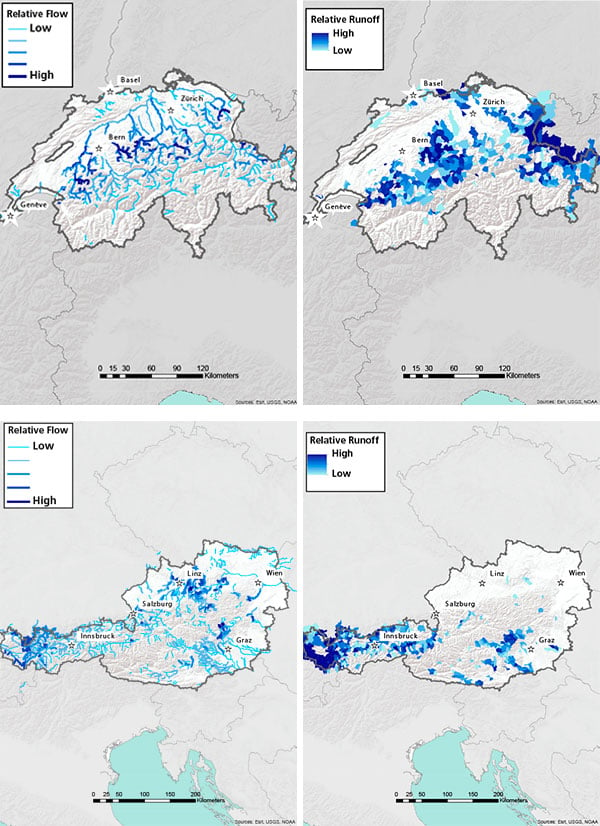
Using region-specific damage functions that capture the vulnerability of the local building stock, the model then calculates damage based on AIR's industry exposure database (IED), a comprehensive database containing the latest information on risk counts, building characteristics, and construction costs. Gross loss estimates were calculated using standard industry policy conditions currently found in Austria and Switzerland, with flood protection from 2005. Figure 7 shows the gross insured loss footprints of the event at CRESTA level.
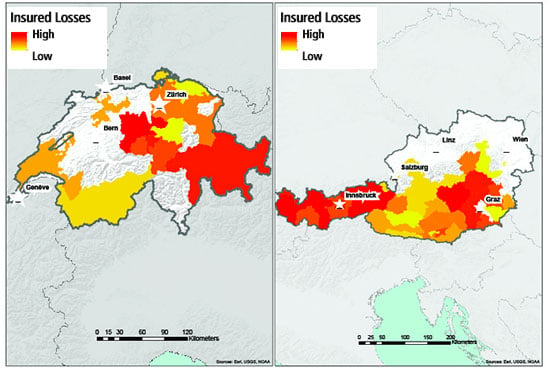
Benchmarking the modeled losses for Austria (EUR 107 million) and Switzerland (EUR 2,102 million) on AIR's industry insured EP curve for each country, the 2005 flood event is far from being exceptional in terms of its frequency. The recurrence interval is about 50 years in Switzerland and just 10 years in Austria on an annual aggregate basis. Risk managers need to prepare for far more damaging floods in Europe's future.
Managing Flood Risk
The major flood events during the past decade or so—many of which have been referred to as "the flood of the century"—have demonstrated that understanding flood risk in Europe has never been more critical. But at the same time, evaluating flood risk is a challenging task because the flood intensity at a given locality depends on many variables, including the continual changes in the characteristics of insured properties, such as new construction materials and building design practices, as well as understanding the severity, frequency, and location of potential flooding.
A probabilistic approach is the only method that can account for all the complex variables associated with flood risk. Flood insurance is becoming an increasingly important measure in risk mitigation. Probabilistic models like the new AIR Inland Flood Model for Central Europe will play an important role in risk assessment by providing insurability of the vast majority of exposed properties and, therefore, opportunities for profitable growth. The model makes full use of a high-resolution, digital terrain model and technological improvements in large-scale weather simulations. It combines historical data with a sophisticated and robust atmospheric model, taking into account the effects of multiple weather systems, snowmelt, the presence of lakes and reservoirs, soil types, flood defenses, regional differences in building vulnerability, and other factors that contribute to flood losses.
The model accounts for current flood defenses and supports user-defined custom flood defenses, which is particularly important for an accurate risk assessment of high-value properties such as industrial facilities. Significantly, unlike many other solutions available in the market, AIR's model explicitly models off-floodplain losses—a major source of insured losses—using a physical rainfall-runoff based modeling approach. Stochastic events are congruent across all four countries and consistently conform to the 504 hours clause.
The model is available in AIR's detailed modeling platform Touchstone® and modeling software CATRADER® for aggregated loss analyses. It currently covers the highly flood-exposed countries of Austria, Czech Republic, Germany, and Switzerland, and additional countries are on the roadmap.
Detailed comments from Dr. Nicolai Thum, Manager, Consulting and Client Services, and Yörn Tatge, Senior Vice President and Managing Director of AIR Worldwide GmbH in Munich, have been gratefully received.
 By: Dr. Korbinian Breinl
By: Dr. Korbinian Breinl